
In the rapidly evolving landscape of generative AI, the conversation is shifting from single-purpose models to sophisticated, multi-agent systems. These systems, where specialized AI agents collaborate to solve complex problems, are the next frontier. For developers navigating this new territory, choosing the right framework is a critical first step. Two powerful contenders have emerged, each with a distinct philosophy and approach: LangGraph and Google’s Agent Development Kit (ADK).
This isn’t just a matter of picking a tool; it’s about selecting a foundational approach to building agentic workflows. This post will break down the core differences between LangGraph and ADK, helping you decide which is the best fit for your project.
LangGraph: The Power of Explicit Control and Statefulness
LangGraph, an extension of the popular LangChain library, is fundamentally about giving developers fine-grained control over their agentic workflows. It treats multi-agent systems as stateful graphs. Think of it as creating a flowchart for your agents, where each step is a node and the transitions between them are explicitly defined edges.
Core Philosophy:
LangGraph is built on the idea that for complex, long-running tasks, you need a deterministic and observable workflow. It’s designed to prevent agents from “veering off course” by providing a clear structure for their interactions. This graph-based approach makes it easier to manage state, handle errors, and debug complex processes.
Key Features:
- Explicit State Management: LangGraph introduces a central “state” object that is passed between nodes. Each node can modify this state, providing a clear and auditable trail of the agent’s reasoning and actions.
- Graph-Based Control Flow: You define the workflow as a graph, with nodes representing functions or agents and edges representing the transitions. This gives you precise control over the order of operations.
- Conditional Logic and Cycles: LangGraph allows for dynamic workflows through conditional edges. This means you can create loops and branches, enabling your agents to adapt their behavior based on the current state.
- Human-in-the-Loop: Integrating human oversight is a natural fit for the graph structure. You can easily create nodes that pause the workflow and await human input or approval.
When to Choose LangGraph:
LangGraph is the ideal choice when you need to build robust, predictable, and highly controllable multi-agent systems. It excels in scenarios where:
- You are building complex, multi-step workflows that require a high degree of reliability.
- Auditability and debugging are critical concerns.
- You need to implement intricate logic with loops, branches, and error handling.
- You are already invested in the LangChain ecosystem and want to leverage its extensive tooling.
In essence, LangGraph provides the low-level control necessary to architect sophisticated, reliable agentic systems from the ground up.
Google’s Agent Development Kit (ADK): A “Code-First” Approach to Scalable Agents
Google’s Agent Development Kit (ADK) is a modular and flexible framework designed to streamline the entire lifecycle of agent development, from prototyping to deployment. Its “code-first” philosophy aims to make building agents feel more like traditional software development, with a focus on creating reusable, hierarchical, and scalable multi-agent systems.
Core Philosophy:
ADK is designed for building production-ready agents that can be easily integrated into larger applications and deployed on Google Cloud. It provides a more structured, higher-level approach compared to LangGraph, with built-in support for common agentic patterns and a rich ecosystem of tools.
Key Features:
- Hierarchical Multi-Agent Systems: ADK is built for creating teams of specialized agents. You can define a clear hierarchy, with a “coordinator” agent delegating tasks to “sub-agents.”
- Diverse Agent Types: The framework offers different types of agents out-of-the-box, including
LlmAgentfor reasoning, andWorkflowAgent(likeSequentialAgentandParallelAgent) for deterministic control. - Rich Tool Ecosystem: ADK provides a wide array of pre-built tools and makes it easy to create custom ones. It’s optimized for the Google ecosystem, with seamless integrations with services like Gemini and Vertex AI.
- Built-in Evaluation and Deployment: ADK includes tools for systematically testing your agents and is designed for easy containerization and deployment on platforms like Google Cloud Run and Vertex AI Agent Engine.
When to Choose ADK:
ADK is an excellent choice for developers who want a more streamlined, “batteries-included” framework for building scalable and production-ready agents, especially within the Google Cloud ecosystem. It is particularly well-suited for:
- Building hierarchical teams of agents with clear roles and responsibilities.
- Projects that require seamless integration with Google Cloud services.
- Developers who prefer a more abstracted, “software development-like” experience for building agents.
- Applications that can benefit from built-in evaluation and deployment pipelines.
Head-to-Head: LangGraph vs. ADK
The Verdict: Which Framework is Right for You?
The choice between LangGraph and ADK ultimately hinges on your project’s specific needs and your development philosophy.
- Choose LangGraph if you are an architect who wants to build from the ground up. If you need precise control over every step of your agent’s workflow, value explicit state management, and want the flexibility to create highly custom, cyclical, and auditable systems, LangGraph provides the powerful, low-level primitives to do so.
- Choose ADK if you are a developer focused on rapid development and scalable deployment. If you prefer a more structured, “batteries-included” framework with pre-built patterns for multi-agent collaboration, seamless integration with a major cloud ecosystem, and a clear path to production, ADK offers a more streamlined and “software-defined” approach.
Both LangGraph and ADK are exceptional tools that are pushing the boundaries of what’s possible with AI. By understanding their fundamental differences, you can make an informed decision and select the framework that will best empower you to build the next generation of intelligent applications.
Source Credit: https://medium.com/google-cloud/langgraph-vs-adk-a-developers-guide-to-choosing-the-right-ai-agent-framework-b59f756bcd98?source=rss—-e52cf94d98af—4




